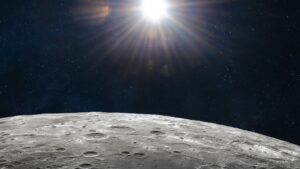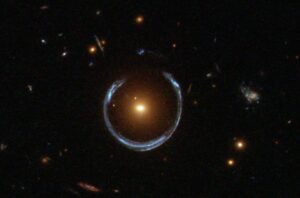During our planet’s long history, objects from deep space have slammed into our planet, scarring it permanently. The earth is pockmarked by the craters they left behind, which have changed Earth’s geology and granted us a deeper understanding of our solar neighbors.
Mistasin Crater
Roughly 36 million years ago, a meteor slammed into subarctic Labrador. The resulting “complex crater” features an elliptical shape and a 50m high crater ring, with a small island in its center. Complex craters are notably shallower than other types. Erosion created its elliptical shape. Over the centuries, glacial melt water filled the crater, forming a freshwater body measuring 16km in diameter.
According to NASA, this impact was so powerful that it a sent powerful shockwave around the planet and altered the climate for decades.

Mistastin crater. Photo: NASA
The presence of cubic zirconia, a mineral used in jewelry, indicates that the meteor’s impact heated the rock to approximately 2,370°C (the temperature required to form this mineral). This would mark the hottest crustal temperature ever recorded on Earth. The surrounding rock also contains anothorsite, which is abundant on the Moon, as well as diaplectic glass, shattered rock, and shock metamorphic rock.
NASA has used the site to train astronauts because of the similarities with our lunar satellite. The local Innu call the crater lake Kamestastin and it lies in the heart of their traditional hunting grounds.
Pingualuit Crater
A few hundred kilometers north of Mistasin, in northern Quebec near James Bay, lies the Pingualuit Crater. Nicknamed the ‘Crystal Eye’ for its exceptionally clear waters, the crater houses one of North America’s deepest freshwater lakes. Pingualuit is Inuktitut for blemish or pimple. From the air, it certainly looks like one on the pristine tundra, an almost perfect circle.
Initially, when pilots from the U.S. and Canadian Air Forces spotted Pingualuit, they did not know what to make of the crater. They flew around it multiple times to make sure it was real. They snapped some photos and sent them to geologists, hoping that some diamond money could be made. But this was a treasure of another kind. Magnetic readings confirmed the presence of meteorite material.
Over 1.4 million years ago, a meteor smashed into this spot on the Ungava Peninsula, leaving a perfectly round 3.5km wide crater. The impact created 160m walls. The water is 400m deep with visibility up to 35m. The lake freezes for nine months a year.

Pingualuit Crater in Canada. Photo: NASA
The site contains impact-melt rocks with high levels of iron, chromium, nickel, and magnetite. One of the most puzzling details of this crater’s history is the presence of arctic char. Scientists are still unsure of how the fish got there. The fish cannibalize each other to survive.
Haughton Crater
If you wish to travel to other planets but don’t have the chops to join NASA, visit Haughton Crater. While the Mistasin Crater shares similarities with the Moon, Haughton is more like Mars.
Still within Canada but much further north, on Nunavut’s Devon Island, the Haughton Crater is the most northerly crater in the world. It’s a desolate, rocky, Mars-like landscape which has made it a good training ground for astronauts with the NASA Haughton-Mars Project. It is part of a wider polar desert, making it quite resistant to erosion.
The crater formed over 23 million years ago, yet was only discovered in the 1950s. British naturalist Reverend Samuel Haughton stumbled upon it while exploring the island.
Average annual temperatures are around -17°C, the ground is always icy with acidic soil, and conditions are exceedingly dry.

A satellite image of the Haughton Crater. Photo: Wikipedia Commons
The crater is 23km in diameter and was formed by a two-kilometer-wide asteroid. The rocky terrain of shale and siltstone provides ideal conditions for astronauts to test equipment and rovers.
Barringer Crater
The Barring Crater is relatively young at 50,000 years old. A meteorite crashed into northern Arizona at 46,000kmph, resulting in a 10-megaton explosion. It melted and shattered the surrounding sandstone and limestone rock. The crater is 170m deep and 1,200m in diameter.

Barringer Crater, Arizona. Photo: Nikolas_jkd/Shutterstock
The crater is privately owned by the Barringer family and got its name from Daniel M. Barringer. Barringer was a businessman and self-taught geologist who was first to suggest the crater was the result of a meteor impact. He claimed the land believing it housed a wealth of minerals, including iron, in which his company specialized.
Barringer made quite a bit of money from the crater thanks to powerful connections (he was acquainted with President Theodore Roosevelt) and a business-savvy brain.
At the time, the consensus was that most craters originated from volcanic activity. Years later, after geological research advanced, geologists determined that a meteor was responsible for Barringer’s crater. The meteoric force that hit this spot would make an atom bomb look like a firecracker.
It is now a major tourist attraction.
Lonar Crater
In Maharashtra, India, you can find the Lonar Crater, also called Lonar Lake. It has been mentioned in various Hindu religious texts since 1600CE. Because of its unusual properties, such as regularly changing colors and sections of both salt and fresh water, Hindus built temples in the area. The crater is used for religious festivals and pilgrimages.
Scientists initially thought the crater had volcanic origins because it sits on the Deccan Plateau. However, the surrounding rocks suggested otherwise. The presence of shattered cones, maskelynite, and shocked breccia rock confirmed that the crater was made by a meteor impact.
Lonar Crater is one of four craters in the world formed on basalt rock. The crater hails from the Pleistocene Epoch and dates to 570,000 years ago. Researchers believe that a meteor traveling at 90,000kmph created the lake.

Lonar Lake turned pink. Photo: Shutterstock
The lake is part saline and alkaline. It contains saline sodas (whose source remains unknown) and also has an isolated alkaline area because of two streams of fresh water.
In 2020, the lake turned from green to a startling pink over three days. High concentrations of haloarchaea microbes were responsible. After an intense monsoon season that year, the lake’s pink color reverted to its usual green.
Tenoumer Crater
In Mauritania, a near-perfect circle punctures the vast Western Sahara. According to NASA, a meteor crashed here around 30,000 years ago. This makes it the youngest impact crater on our list. It may not look as impressive as some other craters on our list because of the Saharan environment; the bottom of the crater is filled with 300m of sand.

Tenoumer crater in Mauritania. Photo: NASA
NASA describes it thus: “The light and shadows make it look more as if someone pressed a giant cookie cutter into the rock.”
However, its unassuming appearance is a trick of the light. The crater rims have very steep walls, they rise above the land in a formidable manner.






